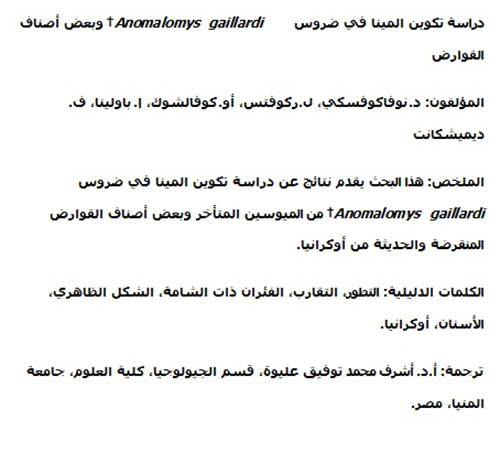Enamel ultrastructure of molars in †Anomalomys gaillardi and some spalacid taxa (Rodentia, Mammalia)
Plain Language Abstract
The enamel ultrastructure of molars in mammals is considered a morphological character having significant taxonomic importance. Different groups of rodents have already been investigated in this aspect. However, the enamel ultrastructure in mole-rats (Spalacidae) and some other groups having morphologically similar molars remains poorly studied. Here we present the results of the study of molar enamel ultrastructure in †Anomalomys gaillardi (Anomalomyidae) from the late Miocene, as well as in some extinct and recent species of the family Spalacidae, in particular †Pliospalax odessanus, †Spalax minor, S. microphthalmus, and S. leucodon. Results show that the tooth enamel of the studied species is multilayered and characterized by a different combination of types (radial, tangential, lamellar) and arrangement of prisms. The most complex enamel structure was found in the species †Anomalomys gaillardi from the late Miocene of Ukraine compared to Pliocene species of the genus †Pliospalax and, especially, to the studied representatives of the genus Spalax. Similar morphological features in representatives of these groups rather reflect their fossorial adaptations, and therefore most likely indicate an evolutionary convergence.
Abstract in Polish
Enamel ultrastructure of molars in †Anomalomys gaillardi and some spalacid taxa (Rodentia, Mammalia)
Ultrastruktura szkliwa zębów trzonowych ssaków uważana jest za cechę morfologiczną o dużym znaczeniu taksonomicznym. W tym aspekcie było analizowane wiele grup gryzoni. Jednak ultrastruktura szkliwa u ślepców (Spalacidae) i niektórych innych grup, mających morfologicznie podobne zęby trzonowe, pozostaje słabo zbadana. Poniżej przedstawiamy wyniki badania ultrastruktury szkliwa trzonowców u †Anomalomys gaillardi (Anomalomyidae) z późnego miocenu, a także u wybranych wymarłych i współcześne występujących gatunków z rodziny Spalacidae, w szczególności † Pliospalax odessanus, † Spalax minor, S. oftalmiczny i S. leucodon. Wyniki pokazują, że szkliwo zębów badanych gatunków jest wielowarstwowe i charakteryzuje się inną kombinacją typów (promieniowe, styczne, płytkowe) i układem pryzmatów. Najbardziej złożoną strukturę szkliwa stwierdzono w gatunku †Anomalomys gaillardi z późnego miocenu z Ukrainy w porównaniu z plioceńskim gatunkiem z rodzaju †Pliospalax, a zwłaszcza z badanymi przedstawicielami rodzaju Spalax. Podobne cechy morfologiczne przedstawicieli tych grup odzwierciedlają raczej ich adaptacje do życia w norach, a zatem najprawdopodobniej wskazują na konwergencję ewolucyjną.
słowa kluczowe: ewolucja; konwergencja; ślepce; morfologia; zęby; Ukraina
Translation by author
Resumen en Español
in progress
Traducción: Enrique Peñalver (Sociedad Española de Paleontología) or Diana Elizabeth Fernández
Résumé en Français
Ultrastructure de l’émail des molaires d’†Anomalomys gaillardi et de certains taxons de spalacidés (Rodentia, Mammalia)
Ce papier présente les résultats d’une étude de l’ultrastructure de l’émail des molaires d’†Anomalomys gaillardi du Miocène récent et de certaines espèces éteintes et actuelles de Spalacidae (Rodentia, Mammalia) d’Ukraine. Nous caractérisons les similarités et différences de la structure de l’émail entre des formes actuelles et éteintes, ainsi qu’entre différents taxons au sein des genres †Anomalomys, †Pliospalax, et Spalax. L’analyse montre que l’émail dentaire des espèces étudiées est composé de plusieurs couches et que ces espèces diffèrent entre elles par la présence de plusieurs types, ainsi que par l’organisation des prismes. Une structure de l’émail plus complexe a été découverte chez †Anomalomys gaillardi du Miocène récent d’Ukraine, par rapport à †Pliospalax du Pliocène, et surtout aux espèces pléistocènes et actuelles de Spalax. Cela nous permet de supposer que les anomalomyidés et les spalacidés sont des parents éloignés et qu’ils ont évolué indépendamment.
Mots-clés : évolution ; convergence ; rats-taupes ; morphologie ; dents ; Ukraine
Translator: Antoine Souron
Deutsche Zusammenfassung
Zahnschmelz Ultrastrukturen bei Molaren von †Anomalomys gaillardi und einigen spalaciden Taxa (Rodentia, Mammalia)
Die Arbeit stellt Ergebnisse einer Untersuchung von Zahnschmelz-Ultrastrukturen bei Molaren von †Anomalomys gaillardi aus dem späten Miozän und einiger ausgestorbener Spalacidae-Arten (Rodentia, Mammalia) aus der Ukraine vor. Wir charakteisieren die Ähnlichkeiten und Unterschiede der Zahnschmelzstruktur zwischen den ausgestorbenen und heutigen Formen ebenso wie zwischen den verschiedenen Taxa der Gattungen †Anomalomys, †Pliospalax und Spalax. Untersuchungen zeigen, dass der Zahnschmelz der untersuchten Arten mehrlagig ist, dass die einzelnen Formen unterschiedlich vorhanden sind und sich in der Anordung der Prismen unterscheiden. Bei †Anomalomys gaillardi aus dem späten Miozän der Ukraine wurde im Vergleich zu dem pliozänen†Pliospalax und besonders dem pleistozänen und heutigen Spalax eine komplexere Zahnschmelzstruktur festgestellt. Dies erlaubt die Annahme, dass Anomalomyiden and Spalaciden wetiläufig verwandt sind und sich unabhängig voneinander entwickelt haben.
Schlüsselwörter: Evolution; Konvergenz; Nacktmulle; Morphologie; Zähne; Ukraine
Translator: Eva Gebauer
Arabic

Translator: Ashraf M.T. Elewa

